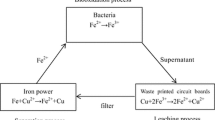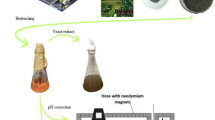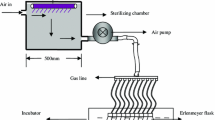Abstract
Purpose of this study was to analyse the ability of isolated Leptospirillum to extract the metals from television printed circuit boards (TV-PCBs). Activation of iron oxidizer enriched from coal sample resulted in 8.5-fold enhancement in iron oxidation rate. The television printed circuit board (TV-PCBs) adapted culture showed 1.2-, 1.3- and 1.6-fold higher Cu, Zn and Ni leaching, respectively, from 10 g/L TV-PCBs waste pulp density compared to unadapted culture. It also showed 24-h reduction in leaching time. The two-step process showed 1.3-fold higher metal extractions compared to one-step process with both adapted and unadapted culture. Additionally, there was a 1.3-fold reduction in reaction time in the two-step leaching process as compared to the one-step process. The effect of change in leaching process parameters such as pH, Fe (III) concentrations, and particle size were investigated. The maximum metal leaching occurred at a pH of 2.0, Fe (III) concentration of 8.2 g/L, and at particle size less than 0.044 mm. Under the above-stated optimum conditions, all the three metal extractions namely Cu, Zn and Ni were greater than 95%.





Similar content being viewed by others
References
Shah, M., Tipre, D., Dave, S.: Chemical and biological processes for multi-metal extraction from waste printed circuit boards of computers and mobile phones. Waste Manag. Res. 32(11), 1134–1141 (2014)
Chen, M., Huang, J., Ogunseitan, O.A., Zhu, N., Wang, Y.: Comparative study on copper leaching from waste printed circuit boards by typical ionic liquid acids. Waste Manag. 41, 142–147 (2015)
Dwivedy, M., Mittal, R. K.: An investigation into e-waste flows in India. J. Clean. Prod. 37, 229–242 (2012)
U.S. environmental protection agency: electronics waste management in the United States approach 1.EPA530-R-08-009, US EPA: Washington, DC (2008)
Chan, O., Valix, M.: Thermogravimetric analysis and kinetic study of biochemically pretreated printed circuit board wastes. Waste. Biomass. Valor. 5, 211–222 (2014)
Widmer, R., Oswald-Krapf, H., Sinha-Khetriwal, D., Schnellmann, M., Boni, H.: Global perspectives on E-waste. Environ. Impact. Assess. Rev. 25, 436–458 (2005)
Ilyas, S., Lee, J., Kim, B.: Bioremoval of heavy metals from recycling industry electronic waste by a consortium of moderate thermophiles: process development and optimization. J. Clean. Prod. 70, 194–202 (2014)
Zhu, N., Xiang, Y., Zhang, T., Wu, P., Dang, Z., Li, P., Wu, J.: Bioleaching of metal concentrates of waste printed circuit boards by mixed culture of acidophilic bacteria. J. Hazard. Mater. 192(2), 614–619 (2011)
Narayanasamy, M., Dhanasekaran, D., Vinothini, G., Thajuddin, N.: Extraction and recovery of precious metals from electronic waste printed circuit boards by bioleaching acidophilic fungi. Int. J. Environ. Sci. Technol. (2016). doi:10.1007/s13762-017-1372-5
Priya, A., Hait, S.: Comparative assessment of metallurgical recovery of metals from electronic with special emphasis on bioleaching. Environ. Sci. Pollut. Res. 24(8), 6989–7008 (2017)
Bas, A., Deveci, H., Yazici, E.A.: Bioleaching of copper from low grade scrap TV circuit boards using mesophilic bacteria. Hydrometallurgy. 138, 65–70 (2013)
Karwowska, E., Morzuch, D.A., Lebkowska, M., Tabernacka, A., Wojtkowska, M., Telepko, A., Konarzewska, A.: Bioleaching of metals from printed circuit boards supported with surfactant- producing bacteria. J. Hazard. Mater. 264, 203–210 (2014)
Mrazikova, A., Marcincakova, R., Kadukova, J., Velgosova, O., Balintova, M.: Influence of used bacterial culture on Zinc and Aluminium bioleaching from printed circuit boards. Nova Biotechnol Chim. 14(1), 45–51 (2015)
Pradhan, J., Kumar, S.: Metals bioleaching from electronic waste by Chromobacterium violaceum and Pseudomonas sp. Waste Manag. Res. 30(11), 1151–1159 (2012)
Makinen, J., Bacher, J., Kaartinen, T., Wahlstrom, M., Salminen, J.: The effect of flotation and parameters for bioleaching of printed circuit boards. Miner. Eng. 75, 26–31 (2015)
Brandl, H., Bosshard, R., Wegmann, M.: Computer-munching microbes: metal leaching from electronic scrap by bacteria and fungi. Hydrometallurgy. 59(2), 319–326 (2001)
Chen, S., Yang, Y., Liu, C., Dong, F., Liu, B.: Column bioleaching copper and its kinetics of waste printed circuit boards (WPCBS) by Acidithiobacillus ferrooxidans. Chemosphere. 141, 162–168 (2015)
Yong, H., Valix, M.: Bioleaching of electronic waste using acidophilic sulphur oxidizing bacteria. J. Clean. Prod. 65, 465–472 (2014)
Ilyas, S., Anwar, M.A., Niazi, S.B., Afzal Ghauri, M.: Bioleaching of metals from electronic scrap by moderately thermophilic acidophilic bacteria. Hydrometallurgy. 88(1), 180–188 (2007)
Dave, S. R., Shah, M.B., Tipre, D. R.: E-waste: metal pollution threat or metal resource? J. Adv. Res. Biotechnol. 1, 1–14 (2016)
Arshadi, M., Mousavi, S.M.: Simultaneous recovery of Ni and Cu from computer-printed circuit boards using bioleaching: statistical evaluation and optimization. Bioresour. Technol. 174, 233–242 (2014)
Liang, G., Ting, J., Liu, W., Zhou, Q.: Optimizing mixed culture of two acidophiles to improve copper recovery from printed circuit boards (PCBs). J. Hazard. Mater. 250–251(4), 238–245 (2013)
Tipre, D., Dave, S.: Bioleaching process for Cu-Pb-Zn bulk concentrate at high pulp density. Hydrometallurgy. 75, 37–43 (2004)
Vogel, I. A.: Textbook of Quantitative Inorganic Analysis, pp. 359, 3rd edn. ELBS and Longman, London (1962)
Dave, S. R., Microbiological and bioleaching studies on metallurgical bacteria cultured from Indian Sulphidic Mine Waters. PhD Thesis, University of Mysore, Mysore (1980)
Patel, B., Tipre, D., Dave, S.: Development of Leptospirillum ferriphilum dominated consortium for ferric iron regeneration and metal bioleaching under extreme stresses. Bioresour. Technol. 118(1), 483–489 (2012)
Norris, P. R.: Iron and mineral oxidation with Leptospirillum-like bacteria.In: Recent Progress in Biohydrometallurgy.calgliari, pp. 83–96 (1983)
Shah, M., Tipre, D., Purohit, M., Dave, S.: Development of two-step process for enhanced biorecovery of Cu-Zn-Ni from computer printed circuit boards. J. Biosci. Bioeng. 220(2), 167–173 (2014)
Panda, S., Mishra, S., Srinivas Rao, D., Pradhan, N., Mohapatra, U., Angadi, S., Mishra, B. K.: Extraction of copper from copper slag: Mineralogical insights, physical beneficiation and bioleaching studies. Korean J. Chem. Eng. 32, 667–676 (2015)
Xiang, Y., Wu, P., Zhu, N., Zhang, T., Liu, W., Wu, J., Li, P.: Bioleaching of copper from waste printed circuit boards by bacterial consortium enriched from acid mine drainage. J. Hazard. Mater. 184(1–3), 812–818 (2010)
Mehta, K.D., Pandey, B.D.: Efficacy of bacterial adaptation on copper biodissolution from a low grade chalcopyrite ore by A. ferrooxidans. Int. J. Nonferrous Metall. 1, 1–7 (2012)
Plumb, J. J., Muddle, R., Franzmann, P. D.: Effect of pH on rates of iron and sulfur oxidation by bioleaching organisms. Miner. Eng. 21, 76–82 (2008)
Priya, A., Hait, S.: Feasibility of bioleaching of selected metals from electronic waste by Acidiphilium acidophilum. Waste Biomass Valor (2017). doi 10.1007/s12649-017-9833-0
Gu, W., Bai, J., Dai, J., Zhang, C., Yuan, W., Wang, J., Wang, P., Zhao, X: Characterization of extreme acidophilic bacteria (Acidithiobacillus ferrooxidans) bioleaching copper from flexible PCB by ICP-AES. J. Spectrosc. 33, 1–8 (2014)
Acknowledgements
The authors are thankful to Department of Science and Technology (DST), New Delhi, India, for the Inspire research scholarship to Asha B.Sodha (IF140456) and University Grants Commission(UGC), New Delhi, for Emeritus Professor Fellowship extended to Shailesh R. Dave.
Author information
Authors and Affiliations
Corresponding author
Rights and permissions
About this article
Cite this article
Sodha, A.B., Qureshi, S.A., Khatri, B.R. et al. Enhancement in Iron Oxidation and Multi-metal Extraction from Waste Television Printed Circuit Boards by Iron Oxidizing Leptospirillum feriphillum Isolated from Coal Sample. Waste Biomass Valor 10, 671–680 (2019). https://doi.org/10.1007/s12649-017-0082-z
Received:
Accepted:
Published:
Issue Date:
DOI: https://doi.org/10.1007/s12649-017-0082-z




